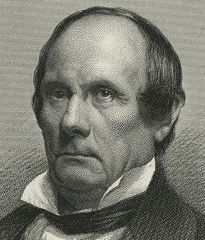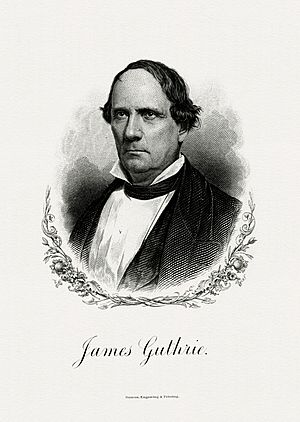James Guthrie (Kentucky politician) facts for kids
Quick facts for kids
James Guthrie
|
|
|---|---|
 |
|
| United States Senator from Kentucky |
|
| In office March 5, 1865 – February 7, 1868 |
|
| Preceded by | Lazarus W. Powell |
| Succeeded by | Thomas C. McCreery |
| 21st United States Secretary of the Treasury | |
| In office March 7, 1853 – March 6, 1857 |
|
| President | Franklin Pierce |
| Preceded by | Thomas Corwin |
| Succeeded by | Howell Cobb |
| Personal details | |
| Born | December 5, 1792 Bardstown, Kentucky, U.S. |
| Died | March 13, 1869 (aged 76) Louisville, Kentucky, U.S. |
| Resting place | Cave Hill Cemetery |
| Political party | Democratic |
| Spouse |
Elizabeth Churchill Prather
(m. 1821; died 1836) |
| Children | 3 |
| Relatives | J. Lawrence Smith (Son-in-law) |
| Signature | |
James Guthrie (December 5, 1792 – March 13, 1869) was an important American politician and businessman from Kentucky. He worked as a lawyer and led a railroad company. He was a member of the Democratic Party.
Guthrie served as the 21st United States Secretary of the Treasury under President Franklin Pierce. Later, he became the president of the Louisville and Nashville Railroad. He also served in the Kentucky state legislature and on the Louisville City Council. After the American Civil War, he became a U.S. Senator for Kentucky.
Guthrie was strongly against Kentucky leaving the United States. He attended a special meeting in 1861 to try and prevent the Civil War. Even though he supported the Union during the war, he turned down President Abraham Lincoln's offer to become the Secretary of War. After the war, as a Senator, he supported President Andrew Johnson.
Guthrie also helped lead the Louisville and Portland Canal Company. He was the first president of the University of Louisville. He also led the Kentucky Constitutional Convention in 1849. During the Civil War, he kept control of the Louisville and Nashville Railroad. He allowed the Union army to use it for troops and supplies.
Contents
Early Life and Family
James Guthrie was born on December 5, 1792. His birthplace was near Bardstown, in Nelson County, Kentucky. His parents were General Adam Guthrie and Hannah Polk. His family had Scottish roots. His grandparents had moved from Ireland.
His father, Adam Guthrie, moved from Virginia to Kentucky. He built a large farm in Nelson County. Adam Guthrie also served in the Kentucky General Assembly several times. Young James Guthrie went to a log schoolhouse. He also studied at McAllister's Military Academy in Bardstown.
In 1812, James Guthrie worked on a flatboat. He helped transport goods down the Ohio River and Mississippi River to New Orleans. After three trips, he decided to study law. He learned law from Judge John Rowan.
In 1821, Guthrie married Eliza Churchill Prather. They had three daughters: Mary Elizabeth, Ann Augusta, and Sarah Julia. Eliza Prather Guthrie passed away in 1836. One of his daughters, Sarah Julia, married a chemist named J. Lawrence Smith.
Career and Public Service
Guthrie became a lawyer in Kentucky in 1817. He started his law practice in Bardstown.
In 1820, Governor John Adair made Guthrie the top lawyer for Jefferson County, Kentucky. Guthrie then moved to Louisville. In 1824, he worked to get Louisville recognized as a city. This effort failed at first. But Guthrie was elected to the town's board of trustees. He later became its leader.
The next year, Guthrie became a director of the Louisville and Portland Canal Company. He helped get money from the government. This money was for a bypass around the Falls of the Ohio. President Andrew Jackson stopped these funds. So, Guthrie found private money. The canal was finished in 1830.
Kentucky State Politics
Voters in Jefferson County, Kentucky elected Guthrie to the Kentucky House of Representatives in 1827. He was a Democrat. In his first year, he led the committee for public improvements. He supported building roads, canals, and a railroad. This railroad would connect Louisville to Frankfort.
In 1828, Guthrie helped Louisville become a city. He was elected to the new city council. He quickly became the head of its finance committee.
Guthrie served in the House until 1831. Then, he was elected to the Kentucky Senate. His fellow lawmakers chose him as the leader of the Senate twice. He worked on committees for finance and education. In 1834, Guthrie helped create the State Bank of Kentucky. He was also one of its directors.
Back in Louisville, Guthrie wanted a new building for city and county offices. He hoped Louisville would become the state capital. A financial crisis in 1837 stopped the building's construction. People called the unfinished building "Guthrie's Folly." But it was later completed. It became the Jefferson County Courthouse.
In 1836, Guthrie helped start the Louisville Medical Institute. This school later became part of the University of Louisville. In 1847, Guthrie became the president of the University of Louisville. He served until he passed away. He also helped create a high school. This school became Louisville Male High School.
Guthrie also pushed for public health and free public schools in Louisville. He convinced the city to buy land for Cave Hill Cemetery. This is where he was later buried.
In 1849, Guthrie represented Louisville at the Kentucky Constitutional Convention. The people at the convention chose him as their president. A main topic was slavery. The Kentucky Constitution of 1850 included rules that protected slave property in the state.
National Service and Politics
President Franklin Pierce saw Guthrie's skill with money. He appointed him Secretary of the Treasury in 1853. Guthrie soon became a very important member of Pierce's team. He believed in "hard money," meaning money backed by gold. He wanted a single currency for the country.
During Guthrie's time, the U.S. Treasury had a lot of extra money. This was because gold was found in California. He used much of this extra money to pay off the national debt. The debt went from $63 million in 1853 to $25 million in 1857. He also bought silver to make coins. This helped banks by putting more money into circulation. Many people thought Guthrie was one of the best Secretaries of the Treasury.
When President Pierce's term ended, Guthrie returned to Louisville. He became the vice-president of the Louisville and Nashville Railroad. The railroad line was finished in 1859. In 1860, Guthrie became the railroad's president. He continued this role through the Civil War.
In 1860, delegates from Kentucky wanted Guthrie to be President of the United States. This was at the Democratic National Convention in Charleston, South Carolina. He received many votes but not enough to win the nomination. He was later offered the job of Secretary of War by President Lincoln. But he declined due to his age and health.
Civil War Years
Even though Guthrie owned enslaved people and supported states' rights, he strongly opposed states leaving the Union. He said that "secession" was a trick. He believed the Southern states should not start a revolution. He thought that if they stayed, they could still influence the government.
At age 70, Guthrie was chosen as a delegate for the Peace Conference of 1861. This meeting was in Washington, D.C. Its goal was to find ways to stop the coming American Civil War. He led the committee that tried to find a compromise. He tried to reintroduce a plan called the Crittenden Compromise.
The committee suggested a plan with seven changes to the Constitution. It used the Missouri Compromise as a guide. This plan would keep the line at 36°30' north latitude. This line would continue to divide areas where slavery was allowed from free areas. The delegates presented this idea to Congress. But Congress rejected it.
Guthrie personally asked President Lincoln to consider the plan. But it did not work. He still believed war could be avoided. He took part in another meeting of border states in May 1861. This meeting also failed to stop the war.
During the war, Guthrie's Louisville and Nashville Railroad was very important. It was the only rail line connecting the North and the South. At first, it carried supplies for the Confederates. But after 1861, it mainly helped the Union. Guthrie remained president of the railroad. It was often attacked by guerrilla fighters. Guthrie made sure the railroad was in better shape after the war than before.
In 1864, Guthrie was a delegate at the 1864 Democratic National Convention in Chicago. He voted for General George B. McClellan for president.
Later Life and Legacy
In 1865, the Kentucky Senate chose Guthrie to be a U.S. Senator. Senator Guthrie was against the Republican Party's plans for Reconstruction. He supported President Andrew Johnson. He was against the Freedmen's Bureau. He also opposed the Fourteenth Amendment.
On February 7, 1868, Guthrie resigned from his Senate position. This was due to his poor health. He had a stroke on April 8, 1868. This left him unable to move much. On June 11, 1868, he also resigned as president of the Louisville and Nashville Railroad.
James Guthrie passed away in Louisville on March 13, 1869. He was buried in Cave Hill Cemetery. The city of Guthrie, Kentucky, is named after him. Guthrie Street in Downtown Louisville also carries his name.
The United States Revenue Cutter Service named several patrol ships after Guthrie. These ships were named in 1868, 1888, and 1895.


